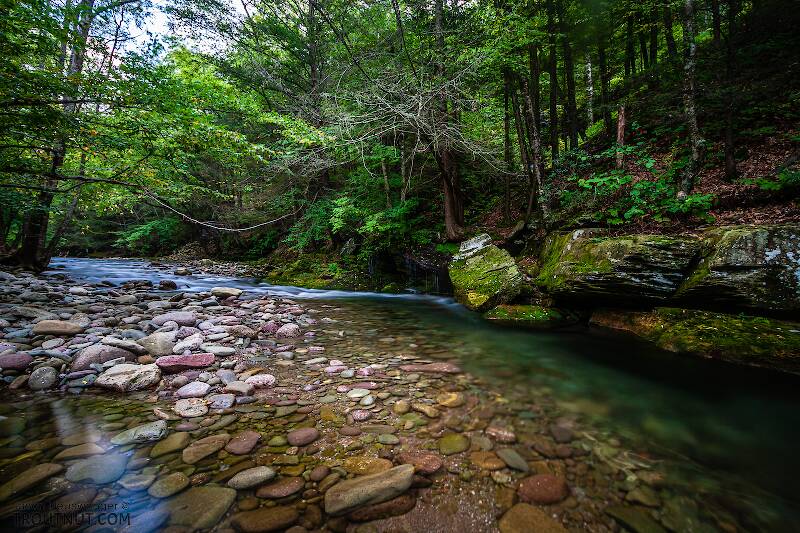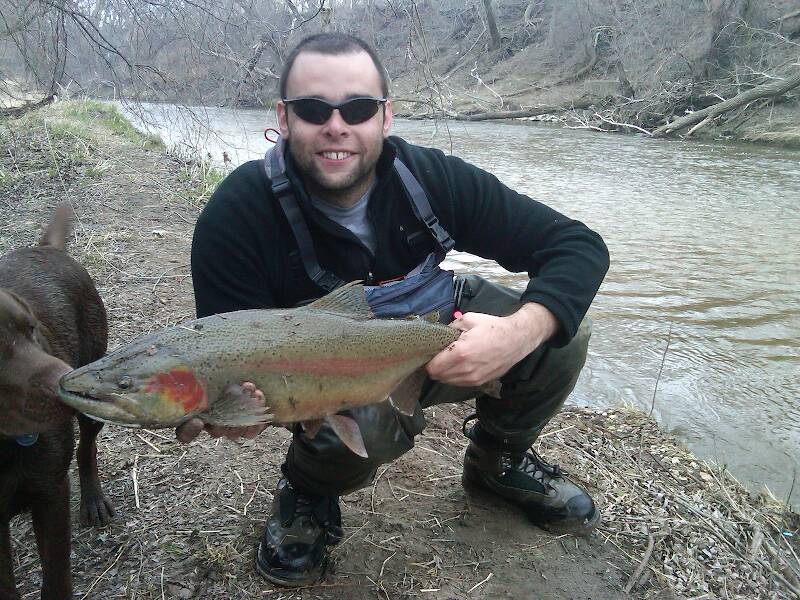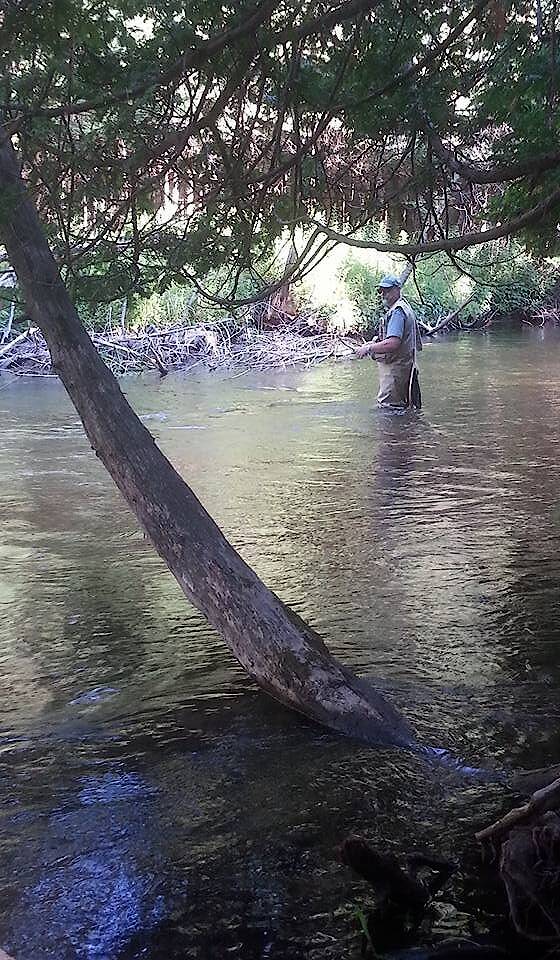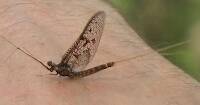
Salmonflies
Pteronarcys californica
The giant Salmonflies of the Western mountains are legendary for their proclivity to elicit consistent dry-fly action and ferocious strikes.
Featured on the forum

This species was fairly abundant in a February sample of the upper Yakima.

Troutnut is a project started in 2003 by salmonid ecologist Jason "Troutnut" Neuswanger to help anglers and
fly tyers unabashedly embrace the entomological side of the sport. Learn more about Troutnut or
support the project for an enhanced experience here.
Gutcutter on Mar 9, 2014March 9th, 2014, 8:18 am EDT
Wow!
Very nice, John.
Very nice, John.
All men who fish may in turn be divided into two parts: those who fish for trout and those who don't. Trout fishermen are a race apart: they are a dedicated crew- indolent, improvident, and quietly mad.
-Robert Traver, Trout Madness
-Robert Traver, Trout Madness
Catskilljon on Mar 9, 2014March 9th, 2014, 8:55 am EDT
Those are very nice Johnny! You tie a mean extended-body! CJ
Entoman on Mar 9, 2014March 9th, 2014, 9:55 am EDT
Excellent, John! I really like the backward slant of the elk hair. Nice body taper, too.
"It's not that I find fishing so important, it's just that I find all other endeavors of Man equally unimportant... And not nearly as much fun!" Robert Traver, Anatomy of a Fisherman
Wiflyfisher on Mar 9, 2014March 9th, 2014, 10:09 am EDT
Excellent, John! I really like the backward slant of the elk hair. Nice body taper, too.
Kurt, thanks! What I am doing now is after I tie in a clump of hair facing forward I pull the hair back, bring the thread directly in front of the hair and tie in another clump of hair facing towards the bend of the hook. The two clumps of hair facing opposite directions keeps the wing stabilized and perfectly upright. After I finish the fly I put a small drop of super glue at the base of the wing. I feel the backward slanted wing gives a better visual appearance from the side, more like the real mayfly duns.
John S.
https://WiFlyFisher.com
https://WiFlyFisher.com
Entoman on Mar 9, 2014March 9th, 2014, 10:23 am EDT
Definitely!
You've come up with a nice solution to my major complaint with this pattern. Kudos!
What are you using for tails and how are you doing the body? Can't quite make these out in the photos.
You've come up with a nice solution to my major complaint with this pattern. Kudos!
What are you using for tails and how are you doing the body? Can't quite make these out in the photos.
"It's not that I find fishing so important, it's just that I find all other endeavors of Man equally unimportant... And not nearly as much fun!" Robert Traver, Anatomy of a Fisherman
Wiflyfisher on Mar 9, 2014March 9th, 2014, 11:18 am EDT
Kurt, I am using some old .021 Orvis nylon tippet material, or any mono 25-30 lb. test. I have had the spools for many years and they have a nice natural curl to them and are fairly stiff.
For the tails I have use both woodduck fibers and/or microfibbets.
I tie the .021 section first onto the hook and then tails. Then I take the hook out of the vise and reverse it. Wind the thread back to where I want it and add the dubbing and wrap it forward. When I get back to the bend of the hook I take the hook out and reverse it again. Sometimes the thread is now wrapping in the wrong direction so I make a couple of half-hitches and now I can wind the thread the right way again. At the point I tie the hair wing on and then go back and finish dubbing the body. Whip finish the head, add the drop of super glue and I am done.
I have used this for size #12 Hendricksons as well. You just have to make sure you grab smaller clump of hair each time since you are adding 2 clumps. Plus, leave enough space between the eye of the hook and the wing to tie in the second clump of hair.
I actually discovered it by accident while tying a comparadun. I tied the hair wing in to sparse and I decided I could salvage the fly by adding some more hair in front of the wing facing the tips backwards. When I finished the fly I realized the wing no longer wanted to flop forwards or backwards. It pretty much stayed in place fully upright and slightly pointing backwards. Even when I tried to bend the wing forward it stayed in place, which totally amazed me. I have been using that technique ever since.
I posted a couple of quick photos I took demonstrating this technique on my blog the other day after spending a few hours tying some the big extended body flies. I thought it might help some others tying larger comparadun patterns.
http://flypatternsfortrout.com/2014/03/08/tying-wing-large-comparadun/
For the tails I have use both woodduck fibers and/or microfibbets.
I tie the .021 section first onto the hook and then tails. Then I take the hook out of the vise and reverse it. Wind the thread back to where I want it and add the dubbing and wrap it forward. When I get back to the bend of the hook I take the hook out and reverse it again. Sometimes the thread is now wrapping in the wrong direction so I make a couple of half-hitches and now I can wind the thread the right way again. At the point I tie the hair wing on and then go back and finish dubbing the body. Whip finish the head, add the drop of super glue and I am done.
I have used this for size #12 Hendricksons as well. You just have to make sure you grab smaller clump of hair each time since you are adding 2 clumps. Plus, leave enough space between the eye of the hook and the wing to tie in the second clump of hair.
I actually discovered it by accident while tying a comparadun. I tied the hair wing in to sparse and I decided I could salvage the fly by adding some more hair in front of the wing facing the tips backwards. When I finished the fly I realized the wing no longer wanted to flop forwards or backwards. It pretty much stayed in place fully upright and slightly pointing backwards. Even when I tried to bend the wing forward it stayed in place, which totally amazed me. I have been using that technique ever since.
I posted a couple of quick photos I took demonstrating this technique on my blog the other day after spending a few hours tying some the big extended body flies. I thought it might help some others tying larger comparadun patterns.
http://flypatternsfortrout.com/2014/03/08/tying-wing-large-comparadun/
John S.
https://WiFlyFisher.com
https://WiFlyFisher.com
JOHNW on Mar 9, 2014March 9th, 2014, 2:20 pm EDT
John,
I may now need to go back and rejoin the Clan of the Comparadun (sort of like Clan of the cave bear but with tweed and gore-tex instead of animal skins). I have never been satisfied with how they turn out for me so I have just fished parachute style flies instead.
I may just need to test them with Spence this spring.
I may now need to go back and rejoin the Clan of the Comparadun (sort of like Clan of the cave bear but with tweed and gore-tex instead of animal skins). I have never been satisfied with how they turn out for me so I have just fished parachute style flies instead.
I may just need to test them with Spence this spring.
"old habits are hard to kill once you have gray in your beard" -Old Red Barn
Wiflyfisher on Mar 9, 2014March 9th, 2014, 4:47 pm EDT
Johnw, comparaduns are an awesome mayfly imitation. I have used them for many years and they do work great! They are also very durable and they are cheaper and easier to tie because they don't require any hackle.
If they are not tied right the wing flops forward and looks awful. When tied correctly they are very effective, durable and look great. You definitely also need the best deer/elk hair you can get. Over the years I have piles of deer and elk hair for tying different size wings. I can't stop in BRF without buying more. It's like an addiction.
A couple of years ago I stopped in at BRF while out West and found some deer hair dyed blue dun color, which IMO looks awesome for all the Ephemerella dun patterns.

If they are not tied right the wing flops forward and looks awful. When tied correctly they are very effective, durable and look great. You definitely also need the best deer/elk hair you can get. Over the years I have piles of deer and elk hair for tying different size wings. I can't stop in BRF without buying more. It's like an addiction.
A couple of years ago I stopped in at BRF while out West and found some deer hair dyed blue dun color, which IMO looks awesome for all the Ephemerella dun patterns.

John S.
https://WiFlyFisher.com
https://WiFlyFisher.com
JOHNW on Mar 10, 2014March 10th, 2014, 5:05 pm EDT
Johnw, comparaduns are an awesome mayfly imitation. I have used them for many years and they do work great! They are also very durable and they are cheaper and easier to tie because they don't require any hackle.
If they are not tied right the wing flops forward and looks awful. When tied correctly they are very effective, durable and look great. You definitely also need the best deer/elk hair you can get. Over the years I have piles of deer and elk hair for tying different size wings. I can't stop in BRF without buying more. It's like an addiction.
John S,
I love to fish them but until now have not been able to tie them for crap (even with a BRF hair hand selected by Craig at the Sommerset Show some years ago).
I tried a few in #14 for sulphurs this evening and lets just say I am going to need to make a little more room in my fly box.
JW
"old habits are hard to kill once you have gray in your beard" -Old Red Barn
Wbranch on Mar 10, 2014March 10th, 2014, 8:16 pm EDT
Pro tyers seem to make tying comparaduns easy when you look at how vertical the wing is in relation to the hook shank. I'm a self taught tier so my methods are probably half assed but what I do is to use a different strength thread to tie in the wing so I can really crank down on the initial tightening turns. Once the wing is secure to the top of the hook shank I take my thumb and forefinger and pull up on the fibers quite aggessively so they are vertical. Then with the bobbin in my right hand and the fibers in my left hand I build up a thread dam in front of the wing. Then go behind and cut off the excess hair on an angle so I can create a nicely tapered foundation for the dubbing. Then I half hitch it and go to 8/0 Uni to finish the fly. I know it is an extra step but as I've said before I could care less if it takes a little longer - it's not like I don't have the time to do it my way. All I do is fish and tie flies for about eight months of the year.
I should of said I tied in the tails before I even started to apply the the wing. Then I build up a fur or synthetic dubbed body and wrap to behind the wing, then go in front of the wing two turns and tie it off. On really big comparaduns like #8 & #10 I usually apply a drop of Krazy glue to the base of the hair before I apply the dubbing. It really stiffens up the base but when I use a hook this big I'm also using 3X tippet so the fly never spins the tippet into a frigging mess.
< />
< />
< />
I should of said I tied in the tails before I even started to apply the the wing. Then I build up a fur or synthetic dubbed body and wrap to behind the wing, then go in front of the wing two turns and tie it off. On really big comparaduns like #8 & #10 I usually apply a drop of Krazy glue to the base of the hair before I apply the dubbing. It really stiffens up the base but when I use a hook this big I'm also using 3X tippet so the fly never spins the tippet into a frigging mess.
< />

< />

< />

Catskill fly fisher for fifty-five years.
Oldredbarn on Mar 10, 2014March 10th, 2014, 8:41 pm EDT
Matt,
That last one there is something else! I don't think you could of gotten that hair stacked any more evenly. Nice! The guy that taught me to tie them would critique the wing and if it wasn't as even as yours there he wasn't happy.
On tiny flies we would stack our hair in an empty twenty-two cartridge. Getting the odd under fur fibers out before you stack the hair is critical.
I really like the fly, have had great success with it, a confidence builder, and I love Matthews' tweak of it, his Sparkle Dun.
Spence
That last one there is something else! I don't think you could of gotten that hair stacked any more evenly. Nice! The guy that taught me to tie them would critique the wing and if it wasn't as even as yours there he wasn't happy.
On tiny flies we would stack our hair in an empty twenty-two cartridge. Getting the odd under fur fibers out before you stack the hair is critical.
I really like the fly, have had great success with it, a confidence builder, and I love Matthews' tweak of it, his Sparkle Dun.
Spence
"Even when my best efforts fail it's a satisfying challenge, and that, after all, is the essence of fly fishing." -Chauncy Lively
"Envy not the man who lives beside the river, but the man the river flows through." Joseph T Heywood
"Envy not the man who lives beside the river, but the man the river flows through." Joseph T Heywood
Wiflyfisher on Mar 11, 2014March 11th, 2014, 4:16 am EDT
Matt, your comparaduns look great!
John S.
https://WiFlyFisher.com
https://WiFlyFisher.com
Wbranch on Mar 11, 2014March 11th, 2014, 5:18 am EDT
"Matt, your comparaduns look great!"
Thank you! I take great pains to make them look pretty and proportioned. I've posted this before but here is my CDC wing Hendrickson & Red Quill compara-dun.
If anyone wants to try a CDC wing compara-dun I use three tips of Trouthunter natural dark dun for my wings. I lay one on top of the other so the tip fibers are all even then lash all three to the hook shank. They are much easier to tie in than hair wings. Then just lift them up vertical and build the thread dam but as you lift them vertical start to tease the fibers out from the center to develop the 130 - 180 degree fan of the wing.
< />
< />
< />
< />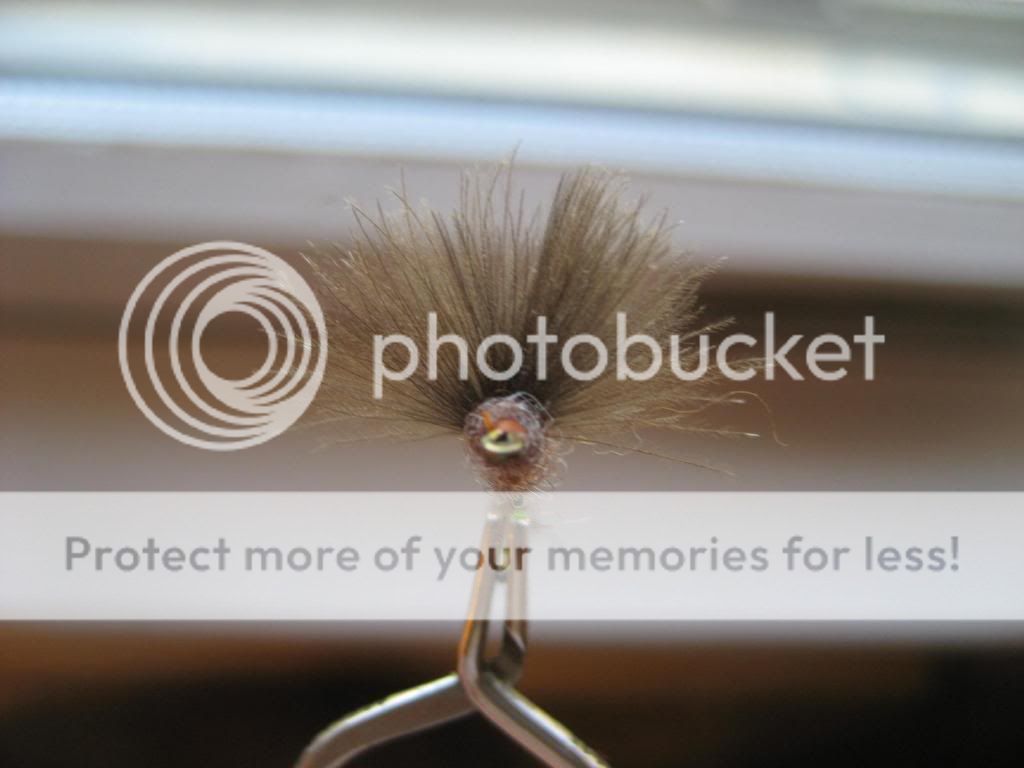
Thank you! I take great pains to make them look pretty and proportioned. I've posted this before but here is my CDC wing Hendrickson & Red Quill compara-dun.
If anyone wants to try a CDC wing compara-dun I use three tips of Trouthunter natural dark dun for my wings. I lay one on top of the other so the tip fibers are all even then lash all three to the hook shank. They are much easier to tie in than hair wings. Then just lift them up vertical and build the thread dam but as you lift them vertical start to tease the fibers out from the center to develop the 130 - 180 degree fan of the wing.
< />

< />

< />

< />

Catskill fly fisher for fifty-five years.
Kschaefer3 on Mar 11, 2014March 11th, 2014, 6:02 am EDT
I've seen these flies before Matt, but damn these are some nice looking flies!
Wbranch on Mar 11, 2014March 11th, 2014, 6:37 am EDT
Hey Grasshopper,
I thought I'd of heard back from you after that humongous email I sent to you about your impending MT trip?? Did you ever see it? If not I can re-send it to you.
If you ever come to stay with me at my cabin I'll show you how to tie them. Are you still on for Montana? Remember I arrive on July 02.
I thought I'd of heard back from you after that humongous email I sent to you about your impending MT trip?? Did you ever see it? If not I can re-send it to you.
If you ever come to stay with me at my cabin I'll show you how to tie them. Are you still on for Montana? Remember I arrive on July 02.
Catskill fly fisher for fifty-five years.
Roguerat on Mar 11, 2014March 11th, 2014, 12:01 pm EDT
Nice flies all around!
this gives us novice tyers something to shoot for, my Comparadun technique is improving and a good example is always helpful (a picture = 1,000 words is very true).
WIflyfisher, do you use an adhesive 'base' on the .021 mono to keep the thread and dubbing from sliding off?
Kudos!!
Roguerat
iI Peter 5:7 'Cast your cares upon Him...'
this gives us novice tyers something to shoot for, my Comparadun technique is improving and a good example is always helpful (a picture = 1,000 words is very true).
WIflyfisher, do you use an adhesive 'base' on the .021 mono to keep the thread and dubbing from sliding off?
Kudos!!
Roguerat
iI Peter 5:7 'Cast your cares upon Him...'
Wiflyfisher on Mar 11, 2014March 11th, 2014, 2:01 pm EDT
Roguerat, I don't use any goop on the mono or on thread and I never seem to have any issues.
BTW, I have been tying the comparadun just like Matt does for at least 40 years. If the thread dam is not built up enough over time I find the wing has a tendency to fall forward. The bigger the fly the more it seems to accent the problem. Also, I always felt the side profile wasn't exactly how I really wanted it, but the flies still worked great anyway.
It was only recently I discovered by mistake placing a second clump of hair in front of the initial clump. After I had tied in a clump of deer hair on a Hendrickson comparadun I realized it was way to sparse. To salvage the fly I decided to place a second clump in front of the wing. It not only worked I really liked how it made the wing stay upright (and slightly slanted back) even when I tried to push it forward. Plus, the side view to me looked much better (my personal preference). When I tried it on the bigger patterns I decided to add a small drop of super glue to the base of the wing and then whip finish. The wing ain't going anywhere after the small drop super glue. There are probably a lot of other guys doing the exact same thing as me.
I have always used heavy gauge mono from old leader kits for tying the extended body. I posted how I do it a while ago here.. http://www.wiflyfisher.com/Hexagenia-Comparadun-Dry-Fly-Pattern.asp. I have also experimented with using wild boar hair instead of mono and posted something here... http://flypatternsfortrout.com/2012/02/22/extended-body-comparadun-using-wild-boar-hair/. The boar hair works fine as well but I think it's pricey for a little swatch of boar hair on a card.

Although I generally use microfibetts for the tail on the really long extended body patterns I would prefer a natural material if it was durable. I have noticed microfibetts curl when in heat or sun, even inside your vest. IMO, Wood duck and other duck flank feathers look much better to me but are flimsy and not as durable.
HTH,
John
BTW, I have been tying the comparadun just like Matt does for at least 40 years. If the thread dam is not built up enough over time I find the wing has a tendency to fall forward. The bigger the fly the more it seems to accent the problem. Also, I always felt the side profile wasn't exactly how I really wanted it, but the flies still worked great anyway.
It was only recently I discovered by mistake placing a second clump of hair in front of the initial clump. After I had tied in a clump of deer hair on a Hendrickson comparadun I realized it was way to sparse. To salvage the fly I decided to place a second clump in front of the wing. It not only worked I really liked how it made the wing stay upright (and slightly slanted back) even when I tried to push it forward. Plus, the side view to me looked much better (my personal preference). When I tried it on the bigger patterns I decided to add a small drop of super glue to the base of the wing and then whip finish. The wing ain't going anywhere after the small drop super glue. There are probably a lot of other guys doing the exact same thing as me.
I have always used heavy gauge mono from old leader kits for tying the extended body. I posted how I do it a while ago here.. http://www.wiflyfisher.com/Hexagenia-Comparadun-Dry-Fly-Pattern.asp. I have also experimented with using wild boar hair instead of mono and posted something here... http://flypatternsfortrout.com/2012/02/22/extended-body-comparadun-using-wild-boar-hair/. The boar hair works fine as well but I think it's pricey for a little swatch of boar hair on a card.

Although I generally use microfibetts for the tail on the really long extended body patterns I would prefer a natural material if it was durable. I have noticed microfibetts curl when in heat or sun, even inside your vest. IMO, Wood duck and other duck flank feathers look much better to me but are flimsy and not as durable.
HTH,
John
John S.
https://WiFlyFisher.com
https://WiFlyFisher.com
Wiflyfisher on Mar 11, 2014March 11th, 2014, 3:01 pm EDT
CDC wing Hendrickson & Red Quill compara-dun
Those look awesome, Matt.
I think you and I would get a long great!
John S.
https://WiFlyFisher.com
https://WiFlyFisher.com
Roguerat on Mar 11, 2014March 11th, 2014, 3:06 pm EDT
I'll start incorporating the 2nd clump of hair, this gives the fly a natural profile and certainly can't hurt flotation.
My first CD's looked like dogs wearing those 'cone' outfits- keeps them from chewing themselves where they shouldn't. Advice from the guys on this site and lots of practice really helped.
As for tailing materials, I can't be the only one who's used paint-brush bristles...I use Fibetts and flank feather, but the bristles do pretty well on larger patterns (Hexes and Drakes!)
Roguerat
I Peter 5:7 'Cast your cares upon Him..'
My first CD's looked like dogs wearing those 'cone' outfits- keeps them from chewing themselves where they shouldn't. Advice from the guys on this site and lots of practice really helped.
As for tailing materials, I can't be the only one who's used paint-brush bristles...I use Fibetts and flank feather, but the bristles do pretty well on larger patterns (Hexes and Drakes!)
Roguerat
I Peter 5:7 'Cast your cares upon Him..'
Quick Reply
Related Discussions
Topic
Replies
Last Reply
3
Jan 16, 2007
by Martinlf
by Martinlf
3
Jul 2, 2008
by Dave_K
by Dave_K
1
Sep 21, 2008
by GONZO
by GONZO

